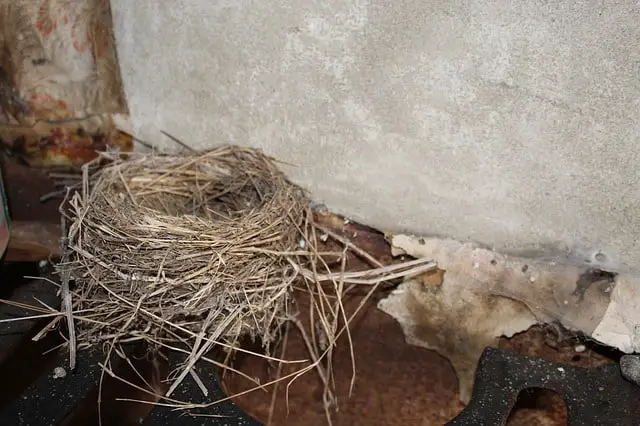Spring has sprung! And that means most people in the country are waking up to the piercing chips of baby birds saying “feed me!”, “feed me now!” And for those unlucky, fuzzy siblings who get pushed out of their nest far too early, you give us pause as we ponder whether or not it’s safe to pick you up. And if I do pick you up, will I catch bird mites?
Well, I’m happy to tackle the subject. I’ve spend many summers as a wildlife rehab volunteer and I’ve been mom to dozens of baby birds over the years both at home and in the animal hospital.
But be warned. Like an on-again, off-again relationship status, the answer to whether or not bird mites are contagious is: it’s complicated. Let’s find out why.
Are bird mites contagious? Technically, Bird Mites CAN spread from a bird to a human during direct contact. They may even bite. However, bird mites cannot use humans as a viable host. They will not be able to survive and reproduce.
Want to learn more about bird mites? Read on…
Types of Bird Mites & Symptoms of Bird Mites
There are three types of bird mites, which affect their hosts in various ways. Bird mites (Starling Mite) usually live on the skin and in the feathers of birds, ingesting their blood, flesh, and even feathers.
This causes an irritation and an itch to the bird’s skin. If the bird is heavily infected, it can become anemic. Anemia is the lowering of red blood cells in the blood.
Birds can also lose their feathers, and their general health can degenerate, affecting egg production in hens, for example. Starlings, pigeons, and swallows are their main hosts.
The second type of bird mite (Scaly Leg Mites), lives in the skin of the bird, which does not have feathers, for example, the ceres (the fleshy part above the beak), and the legs and feet of the bird.
These bird mites cause scales, which thicken, when the infection gets worse. This can cause irritation, deformation of the feet, and eventually the bird may lose its feet. These types of mites live on budgies and canaries.
The third type of bird mite affects the airways and lungs of the bird (Airsac Mites). These mites live in the moist airways, causing respiratory conditions.
For example, rapid breathing, coughing, sneezing, nasal discharge, and the blocking of the trachea, which can cause suffocation and death. These mites usually affect small birds like finches.
Do Bird Mites Spread Diseases?
Although bird mites live off their host’s flesh, contagious diseases are not known to be spread from bird to bird, or from bird to human/animal, via the parasitic bird mite. Bird mites cause local infections on the bird, which can turn into secondary infections.
The Life Cycle of the Bird Mite:
| Stages of the Bird Mite | Duration | Characteristics |
| Eggs | 1 – 2 days | The eggs are white and oval, but cannot be seen by the naked eye. |
| Larvae Stage | On the second day, the larvae hatch. | The three-legged larvae cannot bite. |
| Nymph Stage | Within 24 hours, the larvae change into a nymph. The nymph stage is completed in three to four days. | The molting of the larvae results in a four-legged nymph. The nymph has a mouth to feed on the host’s flesh. |
| Adult | Nymphs turn into an adult bird mite, between 4 to 6 days. After the adult bird mite has fed, it lays eggs and the cycle continues. Bird mites live for 3 weeks, if they have a food source. | The molting of the nymph results in a six-legged adult bird mite. |
Do Bird Mites Cause Problems to Humans?
When birds build their nests by gaining entry to roofs, through broken tiles, of homes or on awning and window ledges, during late spring and summer, they bring bird mites with them.
The bird mites not only feed on the adult birds, but their babies as well. In these conditions the bird mite can thrive. Although they have a short life cycle of 7 days to 3 weeks, they rapidly expand by reproduction.

When the young birds leave the nest, the bird mites are left without a host, and they disperse from the nest, climbing in search of a new host. If they infest a house, they will find a human.
If they are lucky enough to find a human, they will try to feed off human flesh, but are not able to use the human as a host. They will die after 2-3 weeks, if another bird host is not found.
Will I Know if a Bird Mite Bit Me?
This infestation of bird mites in one’s home is not only an inconvenience, but these parasites will bite their human host leaving small, red papules on the skin. So if you begin to notice these signs, stop scratching and get checked out.
Should a person scratch these papules, they can get a secondary skin infection, such as pruritic dermatitis. Bird mites are not usually harmful to humans, but their bites can cause an itch, which causes us to scratch, which could lead to skin issues or infections.
How to Exterminate Bird Mites from Your Home:
- Find the bird mite source: Bird mites will come from an old nest. If you are unable to get access to the inside of your roof, to remove the nest, install a fogger in your ceiling. This will rid the entire roof area of any bird mite infestation.
- Find where the bird mites are crawling: Bird mites are the most active between dusk and dawn. As they are very tiny, place sticky tape in areas where you suspect infestation. You will see the lice stuck to the tape, in a magnifying glass.
- Moisture control: Bird mites thrive in moist conditions. Lowering humidity levels will help the problem. Use a dehumidifier or an air conditioner to ventilate the area or house properly.
- Exterminate the bird mites: In a home without pets or kids, place boric acid in a shaker and shake over all the infected areas. Wash all affected walls with a light solution of bleach and water. (It is best to use this solution in an unseen area, to make sure you don’t discolor your walls.
- Use vinegar as a preventative measure: Mites hate vinegar. Wash walls and floors with vinegar to keep the bird mites away.
- Other exterminator methods: If you are unable to get rid of a very heavy infestation of bird mites, it may be worth getting a pest control company, to eliminate these parasites.
- Chemical
treatment: The pest control company can stray the infected areas
with special chemicals to get rid of bird mites.
- Heat treatment: Heat treatment, which is used for bed bug extermination, also removes bird mites
How to Treat Birds with Bird Mites:
First, always consider turning over fledglings to a wildlife rehabber in your area. Caring for a baby bird requires special skills during feeding so the bird doesn’t aspirate. There are also special techniques that ensure a bird has a good chance of surviving on its own.
But if you have a pet bird with bird mites, call your vet and tell them and discuss bird mite treatements like these:
- Purchase a bottle of Vetafarm Scatt (Price Check): Spray a drop or two onto the affected areas of the bird.
- Air sac Mite: In the case of the Air sac mite, place one or two drops between the shoulder blades.
- Check the bird: Examine the bird after 21 days, before reapplying. If the infestation is gone, redo the process every 3 to 4 months.
- Clean all surfaces: It is no use treating affected birds alone. All cages must be cleaned out and scrubbed with a bleach and water solution (away from the birds) and thoroughly dried before returning birds.
Conclusion
So yeah, technically, bird mites are contagious but no bird mite in it’s right mind would leave a bird for YOU. Humans are not viable hosts and bird mites will die if they try to live off of a human.
But, in the absence of birds, the bird mite will try to survive. They will bite you and their bites can cause irritation.
If you have a pet bird with mites, your bird is not comfortable. Bird mites are parasites depleting your bird of nutrients and making them very uncomfortable. Please get them help.
